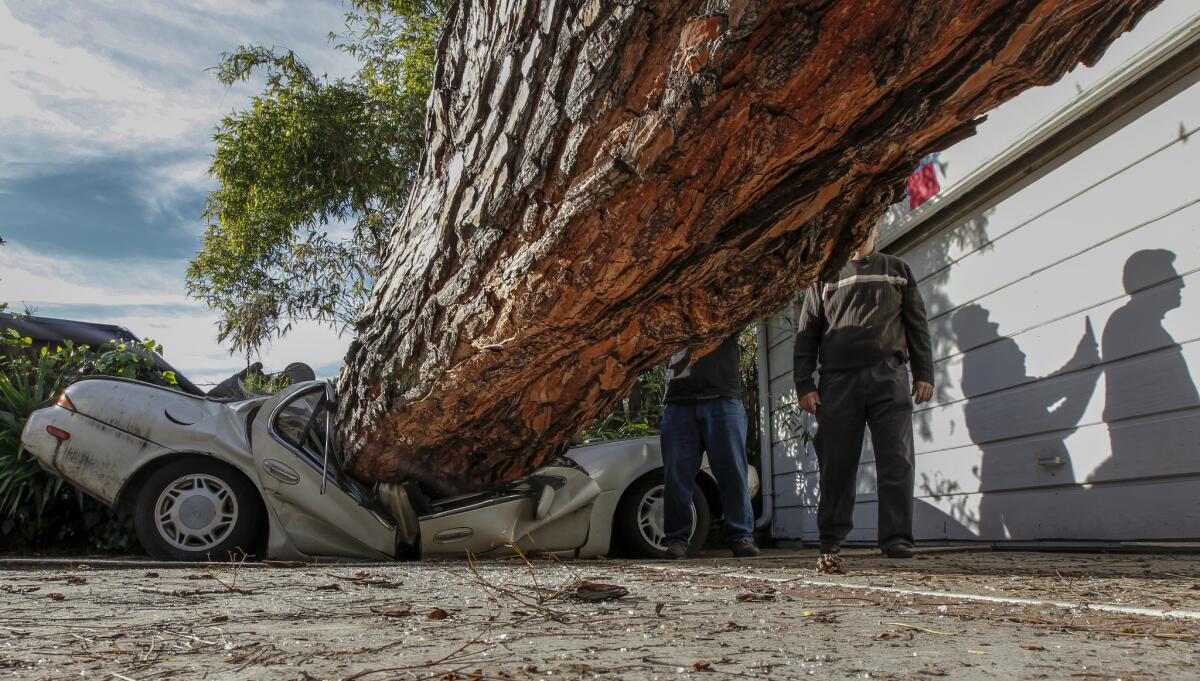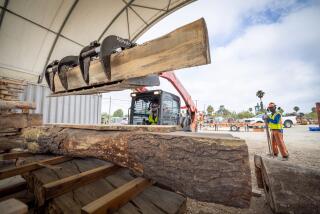Record drought + record rain = toppled trees. How do you know if your tree is in trouble?

- Share via
At Elysian Park near Dodger Stadium last weekend, hikers walked their dogs along the popular hiking trail, unconcerned by a recently toppled tree.
But with more winter storms predicted, and news of a 100-year-old pine tree falling on a house and car in Pasadena on Tuesday, it’s hard for homeowners to be equally nonchalant.
Extended drought followed by heavy rains are causing root instability. Trees aren’t just failing, they are falling over.
“The ground can become like Jell-o once the soil gets to field capacity,” says Daniel Goyette, principal arborist for the Huntington Library, Art Collections, and Botanical Gardens. “It can no longer hold any more water. That’s where you get movement in the soil. It’s why trees are toppling — the soil does not have the rigidity that it usually does.”

So how do you know if your tree is in danger?
Arborist Rebecca Latta recommends looking for changes in the soil near the tree’s roots. “If I see cracking in the soil next to the trunk, then I am very concerned,” she said. “Especially if the homeowner says it is new. That indicates the tree might be moving.”
Goyette advises calling a certified arborist when you see dead branches or notice that the crown of the tree is thinning out. Fungal masses growing at the base of the tree or other sections of the tree are another red flag for homeowners. “It’s an indication that there is wood decay present,” he said.
If you have a tree that might cause great harm, consider taking it out. “You can’t prevent it,” adds Frank McDonough, botanical information consultant at the Los Angeles County Arboretum & Botanical Garden, “but you can certainly evacuate the area where the tree is going to fall.”
Tying may work for a very small tree, Latta said, but a wire or strap is “not going to contain an oak or a eucalyptus tree that weighs a ton.”
In some cases, trees fall over due to something that took place long ago. “It could have been construction or landscaping,” said Goyette. “There could have been a patio or a porch or irrigation work. The roots could have been severed 30 years ago.”
McDonoughsaid that 80% of the tree failures he witnesses are due to the roots being compromised.
The best way to protect roots going forward is to try not to encroach on them by putting a lot of plant material next to the trees. “The area under the canopy should be free and clear of plants,” McDonough said. “The best food for a tree is its own leaves decaying underneath it.”
Horticulturists recommend avoiding excessive pruning, especially at the crown of the tree. “Sometimes topping off a tree makes it worse,” Latta said. “It can actually set the tree up to drop more branches. Pruning can put a tree into a tailspin. It can cause a tree to go on a starvation diet.”
In the face of record rains and powerful winds, McDonough urges homeowners not to panic. “People get the mistaken idea that if you take weight off a tree, it’s less likely to fail,” he said. “Weight is what keeps the tree up.” McDonough offered this analogy: “Trees are like skyscrapers. What keeps a skyscraper up? Its own weight.”
To determine if a tree is dead, look for evidence of life under the bark layer. “If it is fully dead, the growing layer underneath the wood will be dead,” Latta said.
The bottom line: Know the history of your trees. Seek out a certified arborist for a tree hazard evaluation. Evacuate if you think you are in danger.
To find a certified arborist, go to the International Society of Arboriculture, the Tree Care Industry Assn. or treesaregood.com.
A list of things to consider when assessing tree failure:
Do you see any changes in the tree?
Is the tree tilting?
Is the earth on one side of the tree rising?
Is there cracking in the soil next to the trunk?
Are there dead branches, or early leaf drop?
Are there insects or insect holes?
Are there horizontal cracks in the trunk?
Is the canopy less than one third full?
Is there fungus near the trunk?
Was there construction or landscaping where the tree roots might have been rototilled?
Has there been utility work or sewer line construction?
Are there drainage issues? Does the water sit?
Is there a clay layer? Are the roots suffocating?
Answering yes to any of these questions could suggest problems, so it’s best to seek out expert advice.
Twitter: @lisaboone19
For an easy way to follow the L.A. scene, bookmark L.A. at Home and join us on our Facebook page for home design, Twitter and Pinterest.
ALSO:
L.A. area braces for what could be biggest storm of the season; flooding, mudslides possible
What all those dead trees mean for the Sierra Nevada
Recovery plan lies dormant as Elysian Park’s exotic trees die off
You’ve been watering your trees all wrong: A drought expert explains how to get it right






